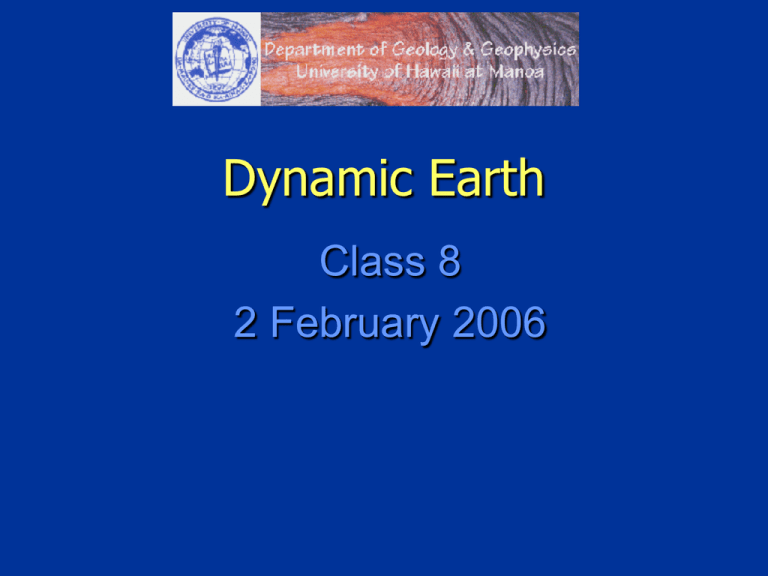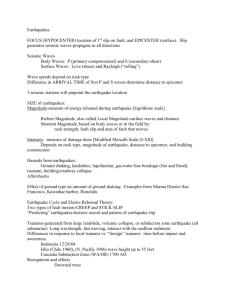Geology of the Hawaiian Islands
advertisement

Dynamic Earth Class 8 2 February 2006 Any Questions? Note: Exam #1 Date shown on hardcopy syllabus as February 14th, but said February 15th. The correct date is February 14th (On-line version is correct) What Plate Tectonics Theory explains Age distribution of oceanic crust (and why the oceans are MUCH younger than the continents) Distribution of earthquakes and volcanoes Seismology Study of the propagation of mechanical energy released by earthquakes. When energy is released in this fashion, waves of motion (like the effect of a pebble tossed into a pond) are set up in the Earth. Earthquakes earthquake: movement of rock bodies past other fault: locus of the earthquake movement faults come at all scales, mm to separation of lithospheric plates (e.g., San Andreas). Earthquake terms focus: site of initial rupture Focus = point where an earthquake originates Earthquake terms focus: site of initial rupture epicenter: point on surface above the focus Seismic Waves Radiate from the Focus of an Earthquake Earthquakes Most damage from ground shaking Eric Marti/AP Photo Chile, May 22, 1960 Magnitude 9.6 earthquake, the largest earthquake ever recorded The city of Valdivia suffered catastrophic damage Severe shaking lasted for over 15 minutes Coastal areas subsided Chile, May 22, 1960 The earth ruptured for 450 miles along the Chile coast The area of rupture was the size of California Elastic Rebound Theory Elastic Rebound Theory Elastic Rebound Theory Elastic Rebound Theory 1906 San Francisco Earthquake Fig. 18.2 1906 San Francisco Earthquake Fault Offset (~2.5m) Seismic waves Waves are started because of initial tension or compression in the rock. Instruments used to measure these waves are called seismographs. Seismographs Record Vertical or Horizontal Ground Motion Vertical Horizontal Modern Seismograph Kinematics Seismograph Record and Pathway of Three Types of Seismic Waves Two kinds of waves from earthquakes P waves (compressional) 6–8 km/s. Parallel to direction of movement (slinky), also called primary waves. Similar to sound waves. S waves (shear) 4–5 km/s. Perpendicular to direction of movement (rope); also called secondary waves. Result from the shear strength of materials. Do not pass through liquids. Comparison of P-wave and S-wave Motion Two Types of Surface Waves Time Lag Between S and P waves with Distance from Epicenter Seismic Travel-time Curve Locating the Epicenter Locating an epicenter The difference between the arrival times of the P and S waves at a recording station is a function of the distance from the epicenter. Therefore, you need three stations to determine the location of an epicenter. Measuring the force of earthquakes 1. Surface displacement 1964 Alaska earthquake displaced some parts of the seafloor by ~ 50 ft. 1906 San Francisco earthquake moved the ground ~8.5 ft. 2. Size of area displaced Alaska — 70,000 sq. miles Measuring the force of earthquakes 3. Duration of shaking Up to tens of seconds 4. Intensity scales Based on damage and human perception 5. Magnitude scales Based on amount of energy released Modified Mercalli Intensity Scale I II III–IV V–VI VII VIII IX X XI XII Not felt Felt only by persons at rest Felt by persons indoors only Felt by all; some damage to plaster, chimneys People run outdoors, damage to poorly built structures Well-built structures slightly damaged; poorly built structures suffer major damage Buildings shifted off foundations Some well-built structures destroyed Few masonry structures remain standing; bridges destroyed Damage total; waves seen on ground; objects thrown into air Richter scale Richter scale: amount of energy received 100 km from epicenter Largest quake ever recorded = 9.6 (rocks not strong enough for more). Earthquakes less than M = 2 are not felt by people. Scale is logarithmic: Increase 1 unit = 10 times greater shaking Increase 1 unit = 30 times greater energy Maximum Amplitude of Ground Shaking Determines Richter Magnitude Richter Magnitude Versus Energy Earthquake prediction Long term—imprecise (can be done) Short term—precise (very difficult) We can't stop earthquakes, so we have to be prepared for them. New Housing Built Along the 1906 Trace of the San Andreas Fault R.E. Wallace, USGS Seismic Hazard Map Distribution of earthquakes Not random Focused in linear zones World Seismicity, 1963–2000 Earthquake distribution defines plate boundaries Core Mantle Yoke Crust Core ? The Earth has a number of layers, just like an egg or an apple Earth’s layers Lithosphere Asthenosphere Plates Rigid Lithosphere with definite boundaries Can have both oceanic and continental crust or just one kind. Note that crust under continents is thicker (~45 km) than under oceans (~8 km). The Earth’s Major Plates Types of plate boundaries Divergent: mid-ocean ridges Convergent: collision zones volcanic arcs Strike-slip: San Andreas Fault (California) Anatolian Fault (Turkey) Divergent (Spreading) Convergent (Subduction Zone) Transform Three Types of Plate Boundaries Earthquakes Associated with Divergent and Transform Margins Strike-slip Faults Subduction Zones Earthquakes in subduction zones Convection within the Earth Lithosphere is created at spreading centers and destroyed at Trenches (Subduction Zones) Subduction zones Ocean-continent convergence Ocean-ocean convergence Continent-continent collision Growth of Continents Addition of volcanic arc material to continent (e.g. Andes). Collisions: Continents Collisions: Exotic terranes Exotic terranes: approaching arc or microcontinent Collision Accreted Terrane The West Coast of North America Exotic Terranes: plastered to the continent at subduction zones Any Questions? Tuesday Finish reading Chapter 3 in the text Thursday Homework # 3 due







